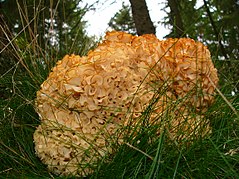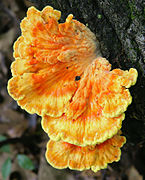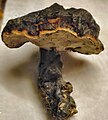Polyporales
| Polyporales | |
|---|---|

| |
| Ganoderma applanatum | |
| Scientific classification | |
| Domain: | Eukaryota |
| Kingdom: | Fungi |
| Division: | Basidiomycota |
| Class: | Agaricomycetes |
| Subclass: | incertae sedis |
| Order: | Polyporales Gäum. (1926)
|
| Families | |
|
Cystostereaceae Fragiliporiaceae[1] Ganodermataceae Gelatoporiaceae Meripilaceae Meruliaceae Phanerochaetaceae Polyporaceae Sparassidaceae Steccherinaceae Xenasmataceae | |
| Synonyms[2] | |
| |
The Polyporales are an
Taxonomy
History
The order was originally proposed in 1926 by Swiss
In a series of publications in 1932,
The order Polyporales was not widely adopted by Gäumann's contemporaries; most mycologists and reference works preferring to use the catch-all, artificial order Aphyllophorales for polypores and other "non-gilled fungi". When an attempt was made to introduce a more natural, morphology-based classification of the fungi in the 1980s and 1990s, the order was still overlooked. A standard 1995 reference work placed most polypores and corticioid fungi in the Ganodermatales, Poriales, and Stereales.[9]
Current status
| |||||||||||||||
| Simplified phylogenetic overview of the families (bolded) and clades (preceded with "/") recognized in Justo et al. 2017. Families marked with (*) were newly created.[10] |
In an extensive molecular analysis, Manfred Binder and colleagues analyzed 6
- Phanerochaetaceae Jülich (1981)
- Irpicaceae Spirin & Zmitr. (2003)
- Meruliaceae Rea (1922)
- Steccherinaceae Parmasto (1968)
- Cerrenaceae Miettinen, Justo & Hibbett (2017)
- Panaceae Miettinen, Justo & Hibbett (2017)
- Hyphodermataceae Jülich (1981)
- Meripilaceae Jülich (1981)
- PodoscyphaceaeD.A.Reid (1965)
- Polyporaceae Corda (1939)
- Fomitopsidaceae Jülich (1981)
- Laetiporaceae Jülich (1981)
- Dacryobolaceae Jülich (1981)
- Sparassidaceae Jülich (1981)
- Grifolaceae Jülich (1981)
- Gelatoporiaceae Miettinen, Justo & Hibbett (2017)
- Incrustoporiaceae Jülich (1981)
- IschnodermataceaeJülich (1981)
Other families that putatively belong to the Polyporales, but for which molecular confirmation is absent or lacking, include
The family
Ecology
The order is
Wood-decay Polyporales reduce the volume of dead wood in the forest and are an important component of the carbon cycle.[13] Wood is composed of primarily three types of tissue: lignin, cellulose, and hemicelluloses. White rot species of Polyporales are efficient degraders of the decay-resistant polymer lignin, leaving partially degraded cellulose as a residue.[13] Brown rot species break down the cellulose fibres, leaving a brittle, brown lignin residue. Brown-rot residues such as humus can remain in the soil for hundreds of years, increasing aeration and water-holding capacity.[23]
Peroxidase enzymes that degrade lignin, such as lignin peroxidase, manganese peroxidase, or versatile peroxidase, are present in all white-rot members of the Polyporales, but absent in brown-rot species.[16][24][25] Oxidase enzymes, including members of the glucose-methanol-choline oxidoreductase family, play a key role in the breakdown of plant polymers because they generate hydrogen peroxide, which acts as the ultimate oxidizer in both white-rot and brown-rot decay.[26]
Two species of Polyporales, Daedalea quercina and Fomitopsis pinicola, use paralysing toxins to destroy and colonize nematodes that feed on their fruit bodies.[27]
Importance
Many wood-decay fungi in the genera Fomes, Fomitopsis and Ganoderma are pathogenic, causing butt and root rot of living trees and consequent losses in forestry plantations. Several species, such as the mine fungus Fibroporia vaillantii, can rot and damage structural timber.[28]
Several of the Polyporales, notably
Some species, including several members of the genera Laetiporus and Sparassis, are used as food.[34] Blackfellow's bread, or Laccocephalum mylittae, is an edible that is prized by Aboriginal Australians.[35] Lentinus squarrosulus is collected and eaten in Asian and African communities.[36]
Fomitopsis betulina was formerly used in the manufacture of
Sequenced genomes
Several member of the Polyporales have had their
Fossil record
Fossilized fruit bodies of a
Molecular clock techniques have been used to estimate the age of the Polyporales, suggesting that the order evolved either during the late Jurassic, about 203–250 Ma,[14] or, in more recent study, about 114 Ma.[49]
Genera Incertae sedis
There are several genera classified in the Polyporales that for various reason have not been assigned to a specific family. They are incertae sedis with respect to familial placement. Some may be poorly known and/or not included in DNA phylogenetic studies, or when they have been, did not clearly group with any named family (In some cases a new family must be created rather than the placement clarified.). These include:
- Aegis Gómez-Montoya, Rajchenb. & Robledo (2017)[50]
- Anthoporia Karasiński & Niemelä (2016)[51]
- Bourdotiella Duhem & Schultheis (2011)[52]
- Crustodontia Hjortstam & Ryvarden (2005)[53]
- Crystallocystidium (Rick) Rick (1940)
- Donkioporiella L.W.Zhou (2016)[54]
- Globosomyces Jülich (1980)[55]
- Globuliciopsis Hjortstam & Ryvarden (2004)[56]
- Irpicochaete Rick (1940)[57]
- Meruliophana Duhem & Buyck (2011)[58]
- Nigrohydnum Ryvarden (1987)[59]
- Phaeophlebiopsis D.Floudas & Hibbett (2015)[25]
- Phlebiella P.Karst. (1890)[60]
- Repetobasidiopsis Dhingra & Avn.P.Singh (2008)[61]
- Rickiopora Westphalen, Tomšovský & Rajchenb. (2016)[62]
- Taiwanofungus Sheng H.Wu, Z.H.Yu, Y.C.Dai & C.H.Su (2004)[63]
-
Phanerochaete chrysorhizon (Phanerochaetaceae)
References
- S2CID 7252657.
- ^ "Trametales Boidin". MycoBank. International Mycological Association. Retrieved 2016-10-16.
- S2CID 4123814.
- ^ Boidin, J.; Mugnier, J.; Canales, R. (1998). "Taxonomie moleculaire des Aphyllophorales". Mycotaxon (in French). 66: 445–491 (see p. 487).
- S2CID 4096339.
- JSTOR 43237358.
- .
- ^ Corner E.J.H. (1932). "The identification of the brown-root fungus". The Gardens' Bulletin; Straits Settlements. 5: 317–350.
- ISBN 978-0-85198-885-6.
- ^ PMID 28800851.
- PMID 17486968. "Archived copy" (PDF). Archived from the original (PDF) on 2011-07-06. Retrieved 2010-11-01.)
{{cite web}}: CS1 maint: archived copy as title (link - S2CID 13102957.
- ^ S2CID 20812924.
- ^ S2CID 9801943.
- ^ S2CID 84643554.
- ^ S2CID 37121590.
- ISBN 978-1-58510-459-8.
- ^ "Index Fungorum - Search Page".
- PMID 29559823.

- S2CID 84739655.
- S2CID 90050530.
- ^ Volk, Tom (2000). "An introduction to the characters used to identify poroid wood decay fungi". McIlvainea. 14 (2): 74–82.
- ISBN 978-0-471-52229-4.
- S2CID 14165783.
- ^ PMID 26228559.
- S2CID 25614887.
- ISBN 978-1-119-10651-7.
- PMID 19476741.
- PMID 24716120.
- PMID 25937256.
- ISBN 978-1-57808-520-0.
- PMID 24786572.
- ISBN 978-0-472-03126-9.
- ISBN 978-1-74224-226-2.
- .
- ISBN 9780470585580.
- .
In Germany, this soft, pliable 'felt' has been harvested for many years for a secondary function, namely in the manufacture of hats, dress adornments and purses.
- JSTOR 3761076.
- ISBN 978-0-8156-0680-2.
- PMID 22735441.
- PMID 25073817.
- PMID 15122302.
- PMID 19193860.
- PMID 28123349.
- PMID 20400566.
- JSTOR 24529677.
- .
- S2CID 1864841.
- hdl:11336/45986.

- S2CID 84992028.
- ^ Hjortstam K, Ryvarden L (2005). "New taxa and new combinations in tropical corticioid fungi, (Basidiomycotina, Aphyllophorales)". Synopsis Fungorum. 20: 33–41.
- S2CID 89715790.
- .
- ^ Hjortstam K, Ryvarden L (2004). "Some new tropical genera and species of corticioid fungi (Basidiomycotina, Aphyllophorales)". Synopsis Fungorum. 18: 20–32.
- ^ Rick, J. (1940). "Resupinati Riograndenses II". Annales Mycologici. 38 (1): 56–60.
- S2CID 86045350.
- ^ Ryvarden L. (1987). "New and noteworthy polypores from tropical America". Mycotaxon. 28 (2): 525–41 (see p. 532).
- ^ Karsten, P.A. (1890). "Fragmenta mycologica XXXI". Hedwigia (in Latin). 29: 270–273.
- ^ Dhingra, G.S.; Singh, Avneet P. (2008). "Validation of Repetobasidiopsis and Trimitiella (Basidiomycetes)". Mycotaxon. 105: 421–422.
- PMID 27521631.
- ^ Wu SH, Yu ZH, Dai YC, Chen CT, Su CH, Chen LC, Hsu WC, Hwang GY (2004). "Taiwanofungus, a polypore new genus". Fungal Science (in Chinese). 19 (3–4): 109–116.
![]() Media related to Polyporales at Wikimedia Commons
Media related to Polyporales at Wikimedia Commons
![]() Data related to Polyporales at Wikispecies
Data related to Polyporales at Wikispecies








